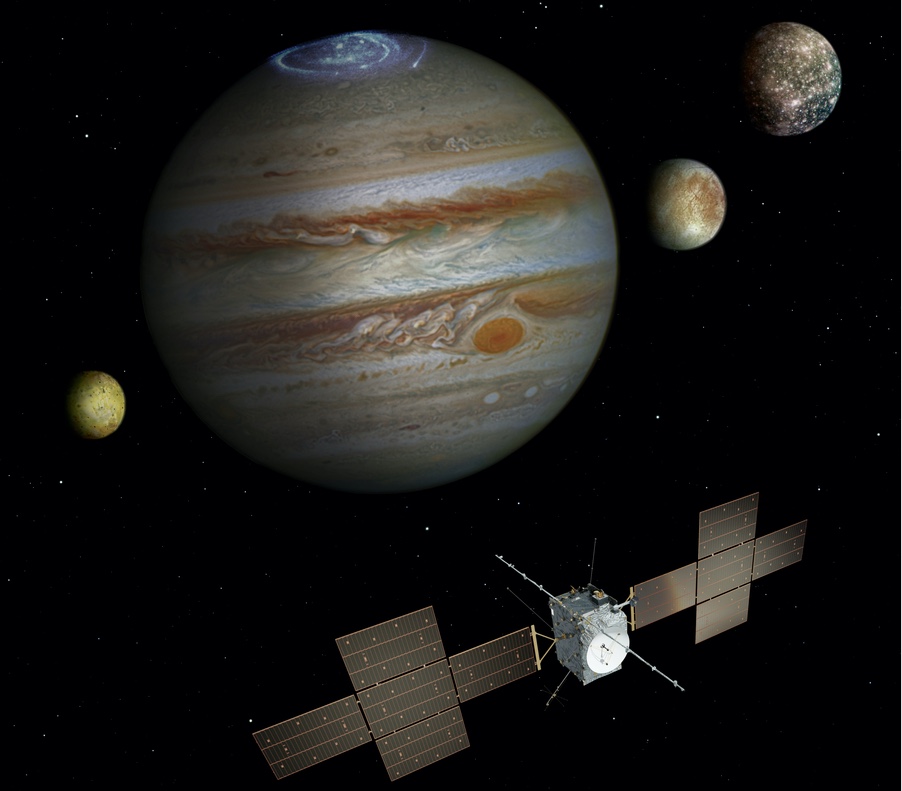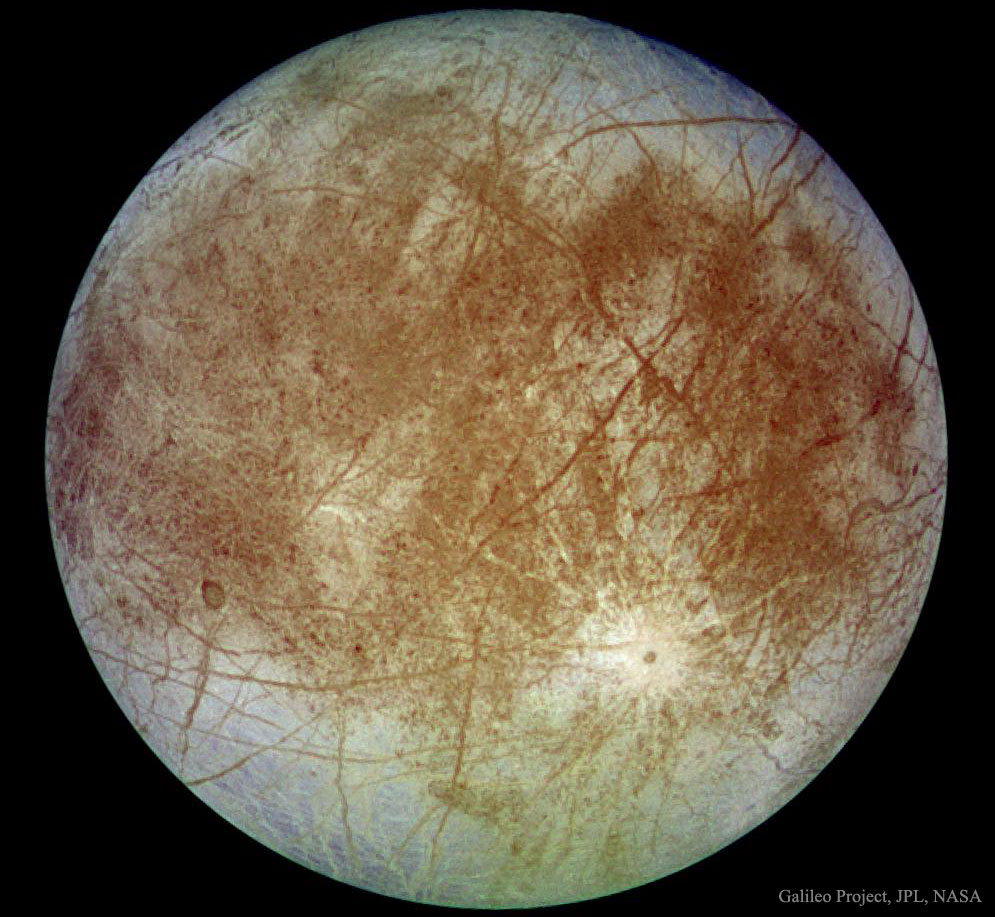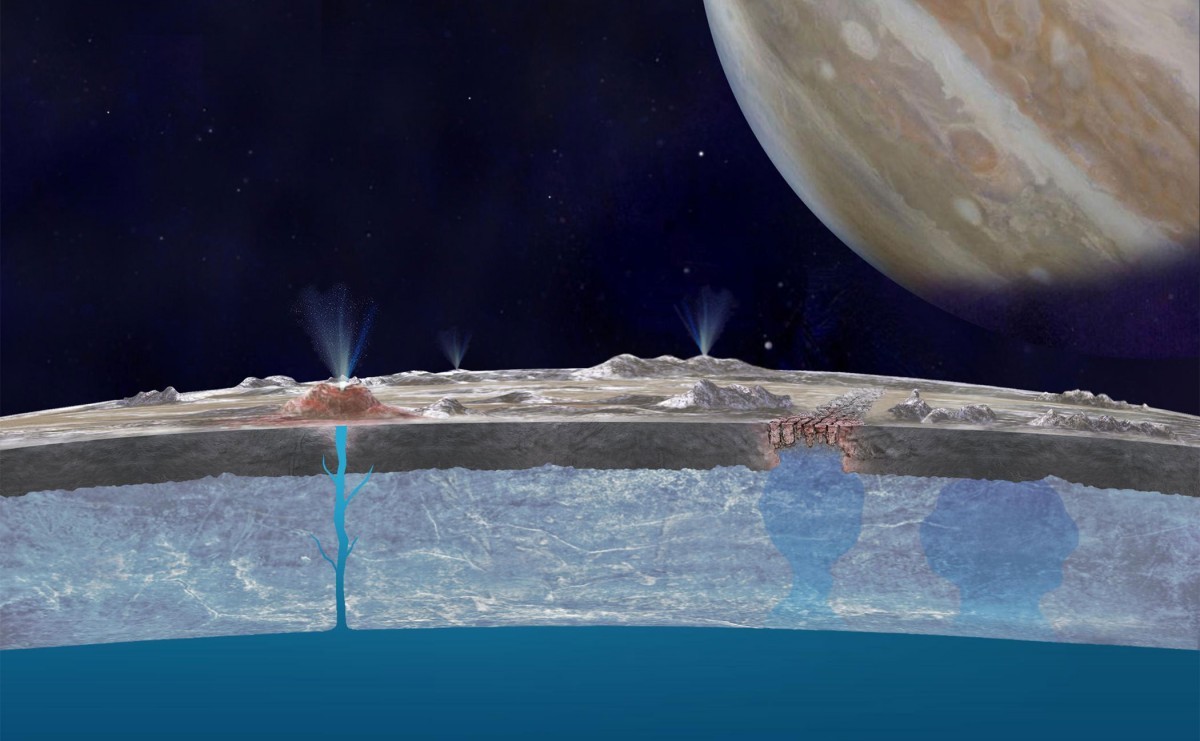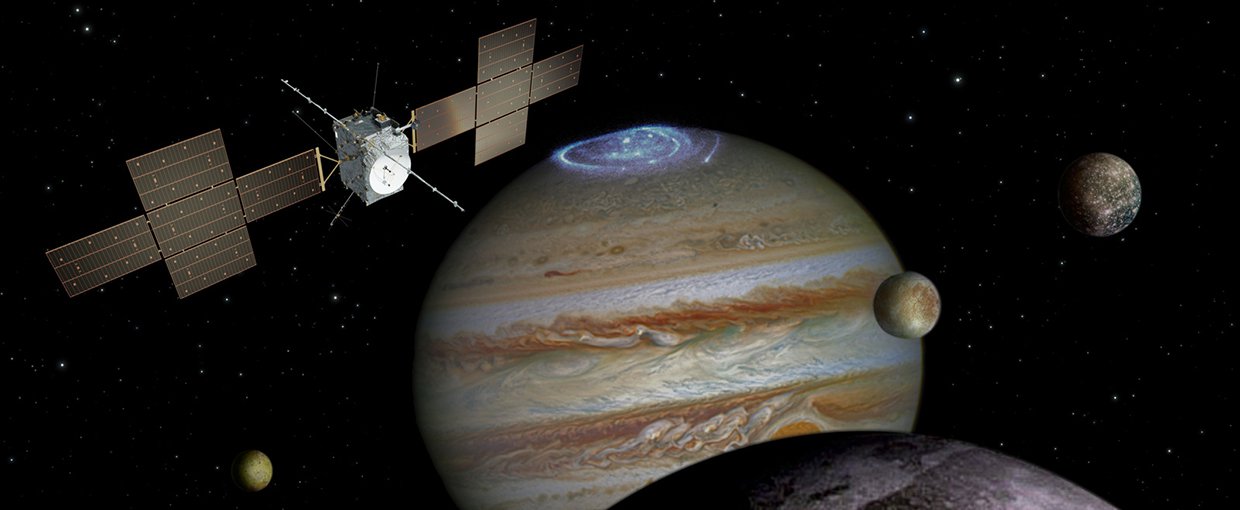Space JUICE
Space scientists love their acronyms!
JUICE stands for JUpiter ICy Moons Explorer.
It will launch in April 2023 and do exactly what it says on the tin.
It will explore the three ice-covered moons of Jupiter.
They are Europa, Ganymede and Callisto.

JUICE at Jupiter Image: ESA
Beneath the ice on these moons, there may be water.
And where there’s water, there could be life.
It is the possibility of finding alien life that has lured JUICE to Jupiter’s moons.
Quick facts
- JUICE is a European Space Agency (ESA) mission.
- Launch date is scheduled between April 14th and 30th, 2023.
- JUICE will fly by Venus, Earth, the Moon and maybe an asteroid enroute to Jupiter
- Arrival at Jupiter in 2031.
- It will spend 3 years studying Jupiter and its three large ice-covered moons.
- Entry in orbit around Ganymede in 2034.
- Deorbit and crash into Ganymede to end mission in 2035.
Launch & Trajectory
JUICE will launch on an Arianne V rocket from the Space Centre in French Guiana.
A series of gravity-assist flybys will speed it on its way to Jupiter.
It will flyby the Earth and Moon in August 2025 and accelerate.
A year later it will encounter Venus and speed up still more.
Two more Earth flybys will follow in September 2026 and January 2029.
On its way to the outer solar system, JUICE will pass through the asteroid belt.
It may pass close to asteroid 223 Rosa at this time.
When it arrives at Jupiter in 2031, JUICE will enter orbit around Jupiter.
In July 2032 it will flyby Europa, the smallest of the four Galilean moons.
After studying Jupiter close-up, the spacecraft will go on to Ganymede.
It will enter orbit around the moon in December 2034.
This will make it the first spacecraft ever to orbit the moon of another world.
At its lowest point, JUICE will fly over Ganymede at a height of only 500km.
Mission Targets
Jupiter has 92 known moons. Most are small, asteroid-like bodies.
The four great Galilean moons contain 99% of the mass of all Jupiter’s moons.
In order from the planet they are Io, Europa, Ganymede and Callisto.

Io Europa Ganymede Callisto Credit:NASA
Io will not be visited by JUICE.
Caught between the gravitational pull of Jupiter and the other moons, Io is pock-marked by active volcanoes.
The other three moons are covered in ice, with oceans of water beneath.
That water may harbour alien life.
It’s possible that JUICE may find evidence of life elsewhere in our Solar System.
The spacecraft will carry instruments to look into the icy crusts.
They will also give high definition images of the ice surfaces of the moons.
Callisto
Callisto is the outermost of the four great moons.
It orbits almost 1.9 million km from Jupiter, keeping the same side facing the planet, like our Moon.
At 4820 km across, it is almost the same size as Mercury.
It is Jupiter’s second biggest moon.

Size of Earth, Moon and Callisto Image: NASA/JPL/DLR
Callisto is made of rock and ice in roughly equal amounts.
It seems to have a thick ice layer overlaying a rocky core.
Between the rock and ice there may be an ocean of water.

Callisto NASA / Galileo
The surface is heavily cratered.
The craters stand out white against the dark ice.
Europa

Europa NASA/JPL
This is the smallest of the Galilean satellites, at 3120 km across.
Europa orbits Jupiter at a distance of 670,000 km.
The moon probably has a metallic iron core surrounded by a rock mantle.
The rock is covered n water-ice some 100km thick.
This outer ice layer is very smooth.

Structure of Europa NASA/JPL
Between the ice and rock there may be a layer of salt water, an ocean beneath the ice.
Deep cracks criss-cross the even surface.
Water vapour plumes rising from cracks have been recorded by the Hubble Space Telescope and the Galileo space probe.
It seems likely that the ocean of water is real.

Possible structure of Europa’s ocean. Credit: NASA/JPL/Caltech
JUICE will make two flybys of Europa in 2032.
Ganymede

Earth, Moon and Ganymede compared. Image:NASA/JPL/DLR
Ganymede is the largest of Jupiter’s moons.
In fact it is the biggest moon in the Solar System, bigger than the planet Mercury.
And Ganymede is the primary target of the JUICE mission.

Ganymede from Juno Image: NASA/JPL-Caltech/SwRI/MSSS
Ganymede is 5628km across.
It orbits Jupiter at a distance of just over a million kilometres in 7 days.

Ganymede surface, Juno mission Credit: NASA/JPL-Caltech/SwRI
Ganymede’s icy surface is scratched by numerous grooves, overlaid by impact craters.
One model of the moon’s interior has an iron core overlaid by a rocky mantle.
Above this rock is an ice mantle.
Then comes the salt water ocean trapped by a surface layer of ice.
Could there be life in that ocean?
Maybe JUICE will get us nearer to the answer.

Ganymede interior WDDA
An unhappy ending?
JUICE will run out of fuel in 2035.
It will then be deliberately crashed into Ganymede.
Right now, I feel unhappy about this idea.
On the face of it, we may contaminate another world with microbes from Earth.
We certainly need some solid reassurance that no contamination can take place.
Europa in Wonderdome
Many of our Wonderdome shows feature a full dome sequence on Europa.
We take a dramatic dive down a crack in the ice and into the ocean beneath.
Do we find life there?
If you’re in a school, please book us and find out!
The author: Dennis Ashton is a Fellow of the Royal Astronomical Society and a Wonderdome presenter.
Would you like to hear more Astronomy news?
Do you want to to find out about our upcoming public events?
Follow WonderDome Portable Planetarium on Twitter and Facebook or go to our web site wonderdome.co.uk

